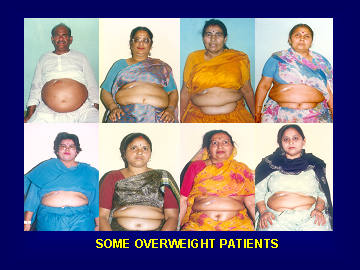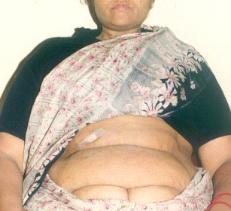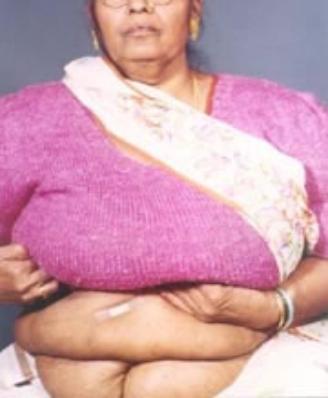SAGES ANNUAL MEET, DALLAS, TX, USA 2006
Hepatobiliary/Pancreatic Surgery–P367
SINGLE HOLE CHOLECYSTECTOMY - HOW I DO IT AFTER 2700 CASES.
MANMOHAN VARMA MS, PRIVATE - KANPUR, INDIA
OBJECTIVES:To achieve a minimally invasive surgery safer than laparoscopic cholecystectomy (LC).
"Laparoscopic assisted intraoperative ultrasound guided single hole cholecystectomy" has evolved with lesser
chances of bile duct injury (BDI), it also does not have problems of indirect vision, hand eye coordination,
pneumoperitoneum, trocar injuries and other complications unique to LC. METHODS: Microlap cholecystectomy
is performed through a small rectus splitting incision (3 - 3.5 cms) in right hypochondrium. This is called "Single
hole". Intraoperative ultrasound is done using 6.5 MHz end firing sector probe to avoid BDI. Bile duct system is
recognized by standard features on ultrasound. Cystic duct is hooked with suture and traction is given while
intraoperative ultrasound is used to see that bile duct is secure and not kinked. 0º, 30º & 45º endoscopes or
Hepatobiliary/Pancreatic Surgery–P367
SINGLE HOLE CHOLECYSTECTOMY - HOW I DO IT AFTER 2700 CASES.
MANMOHAN VARMA MS, PRIVATE - KANPUR, INDIA
OBJECTIVES:To achieve a minimally invasive surgery safer than laparoscopic cholecystectomy (LC).
"Laparoscopic assisted intraoperative ultrasound guided single hole cholecystectomy" has evolved with lesser
chances of bile duct injury (BDI), it also does not have problems of indirect vision, hand eye coordination,
pneumoperitoneum, trocar injuries and other complications unique to LC. METHODS: Microlap cholecystectomy
is performed through a small rectus splitting incision (3 - 3.5 cms) in right hypochondrium. This is called "Single
hole". Intraoperative ultrasound is done using 6.5 MHz end firing sector probe to avoid BDI. Bile duct system is
recognized by standard features on ultrasound. Cystic duct is hooked with suture and traction is given while
intraoperative ultrasound is used to see that bile duct is secure and not kinked. 0º, 30º & 45º endoscopes or


| THIS PAPER WAS ALSO PRESENTED AT 10TH WORLD CONGRESS OF ENDOSCOPIC SURGERY, BERLIN Sept 2006 |
| SINGLE HOLE SURGERY FOR GALL BLADDER STONE |

sinuscopes are used to assist in surgery if and when needed. RESULTS: 2700 single hole cholecystectomies have been done from November 1991 to
December 2004. Of these 2160 were from May 1996 to December 2004 using intraoperative ultrasound routinely & endoscopes when needed in later
phase of study. Hemostasis is convenient due to direct 3D view enabling quick suction, precise pressure and cautery. After May 1996 only 10 (0.4%)
were converted to laparotomy due to bleeding or adhesions. Other 2150 (99.6%) patients were discharged 6 to 24 hours after surgery, 4% had mild
wound infection. 0% suffered BDI or other injury compared to 0.5% to 2.7% incidence of BDI quoted in LC (0.2% to 0.5% at tertiary centres). LC has an
equal number of other injuries also. CONCLUSION: Single hole cholecystectomy done this way is called "Laparoscopic assisted - intraoperative
ultrasound guided-single hole cholecystectomy (LAIOUSC)". It is a safe, minimally invasive surgery with advantages of being gas-less as well as having
direct 3D view or laparoscopic view if needed. This technique has not been reported from elsewhere in the world.
December 2004. Of these 2160 were from May 1996 to December 2004 using intraoperative ultrasound routinely & endoscopes when needed in later
phase of study. Hemostasis is convenient due to direct 3D view enabling quick suction, precise pressure and cautery. After May 1996 only 10 (0.4%)
were converted to laparotomy due to bleeding or adhesions. Other 2150 (99.6%) patients were discharged 6 to 24 hours after surgery, 4% had mild
wound infection. 0% suffered BDI or other injury compared to 0.5% to 2.7% incidence of BDI quoted in LC (0.2% to 0.5% at tertiary centres). LC has an
equal number of other injuries also. CONCLUSION: Single hole cholecystectomy done this way is called "Laparoscopic assisted - intraoperative
ultrasound guided-single hole cholecystectomy (LAIOUSC)". It is a safe, minimally invasive surgery with advantages of being gas-less as well as having
direct 3D view or laparoscopic view if needed. This technique has not been reported from elsewhere in the world.
11th World Congress of Endoscopic Surgery
September 2 - 5, 2008 Yokohama, Japan
WP60-10
SINGLE HOLE CHOLECYSTECTOMY - HOW I DO IT AFTER 3500 CASES
Surgery, Private, India Manmohan Varma
AIM: To design a minimally invasive surgery safer than laparoscopic cholecystectomy
(LC), Laparoscopic assisted intraoperative ultrasound guided single hole
cholecystectomy (LAIOUSC) has evolved with fewer bile duct injury (BDI), no
problems of indirect vision, pneumoperitoneum, trocar injury and other complications
unique to LC. METHOD: Microlap cholecystectomy is done by a small
(3 - 3.5 cms) rectus splitting incision (Single hole). Intraoperative ultrasound
(IOUS) employs 6.5 MHz end firing probe to avoid BDI. Endoscope is used
when needed. RESULT: 3500 single hole cholecystectomies were done from
November 1991 to November 2007. Of these 2960 were after May 1996 using
IOUS routinely and endoscope in later period. 13 (0.4%) were converted to
laparotomy, 2947 (99.6%) were discharged 6 to 24 hours after surgery. Hemostasis
was easy due to direct 3D view enabling quick suction, precise pressure and
cautery. 1 (0.03%) had BDI compared to 0.2% to 1.4% incidence in LC which
has an equal number of other injuries also. CONCLUSION: LAIOUSC is safe,
minimally invasive gasless surgery having direct 3D and laparoscopic view. This
technique has not been reported from elsewhere in the world.
September 2 - 5, 2008 Yokohama, Japan
WP60-10
SINGLE HOLE CHOLECYSTECTOMY - HOW I DO IT AFTER 3500 CASES
Surgery, Private, India Manmohan Varma
AIM: To design a minimally invasive surgery safer than laparoscopic cholecystectomy
(LC), Laparoscopic assisted intraoperative ultrasound guided single hole
cholecystectomy (LAIOUSC) has evolved with fewer bile duct injury (BDI), no
problems of indirect vision, pneumoperitoneum, trocar injury and other complications
unique to LC. METHOD: Microlap cholecystectomy is done by a small
(3 - 3.5 cms) rectus splitting incision (Single hole). Intraoperative ultrasound
(IOUS) employs 6.5 MHz end firing probe to avoid BDI. Endoscope is used
when needed. RESULT: 3500 single hole cholecystectomies were done from
November 1991 to November 2007. Of these 2960 were after May 1996 using
IOUS routinely and endoscope in later period. 13 (0.4%) were converted to
laparotomy, 2947 (99.6%) were discharged 6 to 24 hours after surgery. Hemostasis
was easy due to direct 3D view enabling quick suction, precise pressure and
cautery. 1 (0.03%) had BDI compared to 0.2% to 1.4% incidence in LC which
has an equal number of other injuries also. CONCLUSION: LAIOUSC is safe,
minimally invasive gasless surgery having direct 3D and laparoscopic view. This
technique has not been reported from elsewhere in the world.

